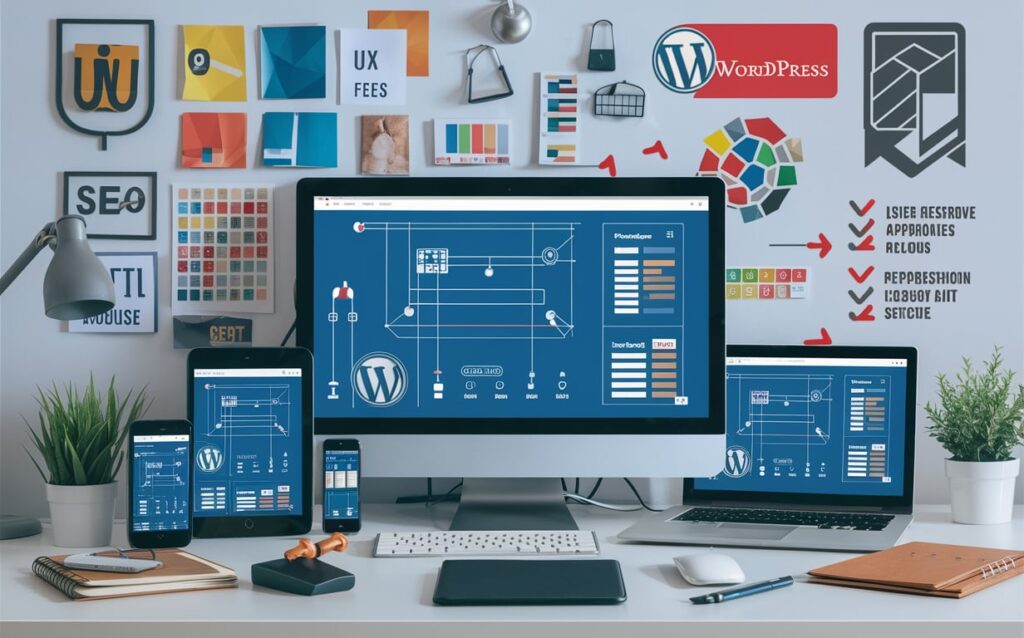Redesigning a WordPress website can be a transformative process that significantly improves its functionality, user experience, and overall effectiveness. Whether you’re looking to update your site’s visual appeal, enhance its performance, or integrate new features, having a comprehensive checklist can guide you through each critical step of the redesign process. This ultimate checklist will ensure that you don’t overlook any crucial elements and that your redesign is executed smoothly and successfully.
Redesign a WordPress Website
Redesigning a WordPress website involves more than just changing the look and feel of your site. It encompasses a range of tasks, from evaluating your current site’s performance to implementing new design elements and ensuring that everything works flawlessly. A well-structured redesign process is essential to achieve your goals and provide an optimal experience for your visitors. In this blog post, we’ll walk you through a detailed checklist to help you redesign your WordPress website effectively.
Assessing Your Current Website
Before diving into the redesign, it’s crucial to assess your current website’s strengths and weaknesses. This evaluation will help you understand what needs improvement and what should be retained in the new design.
Analyze Website Performance
Start by evaluating your website’s current performance metrics. Tools like Google Analytics can provide insights into page load times, bounce rates, and user behavior. Understanding these metrics will help you identify performance issues that need addressing.
Review User Feedback
Collect feedback from users about their experience with your site. Look for common complaints or suggestions, and consider how these insights can inform your redesign. User surveys, feedback forms, and direct comments are valuable sources of information.
Audit Content
Conduct a content audit to assess the quality and relevance of your existing content. Identify outdated or underperforming content that needs updating or removal. Ensure that your new design will support and enhance your content strategy.
💖 You Might Also Like
Setting Redesign Goals
Clear goals are essential for a successful redesign. Determine what you want to achieve with the redesign, such as improving user engagement, boosting conversions, or modernizing the site’s appearance.
Define Objectives
Outline specific objectives for the redesign. For example, you might aim to increase traffic by 20%, reduce bounce rates by 15%, or enhance mobile usability. Clear objectives will guide your design decisions and help measure the redesign’s success.
Identify Target Audience
Understanding your target audience is crucial for designing a website that meets their needs. Analyze demographic data, preferences, and behavior to create a design that appeals to your audience and addresses their pain points.
Competitive Analysis
Study your competitors’ websites to identify industry trends and standards. Analyzing competitors can provide inspiration and help you pinpoint areas where you can differentiate your site.
Planning the Redesign
Effective planning is key to a smooth redesign process. Create a detailed plan that outlines each step of the redesign and assigns responsibilities to team members.
Develop a Timeline
Establish a realistic timeline for the redesign project. Include milestones for each phase of the process, such as design approval, development, and testing. A well-defined timeline will help keep the project on track and ensure timely completion.
Budget Allocation
Determine the budget for the redesign project. Factor in costs for design, development, content creation, and any additional tools or services required. Allocating a budget will help you manage expenses and avoid unexpected costs.
Choose a Design Approach
Decide whether you will use a pre-built theme, customize an existing theme, or create a custom design from scratch. Each approach has its pros and cons, so choose the one that aligns with your goals and budget.
Design and User Experience
Design plays a significant role in user experience and overall site effectiveness. Focus on creating a design that is visually appealing, user-friendly, and aligned with your brand.
Create Wireframes and Mockups
Develop wireframes and mockups to visualize the new design layout. Wireframes provide a basic structure, while mockups offer a more detailed representation of the final design. Use these tools to gather feedback and make necessary adjustments before proceeding to development.
Focus on Mobile Responsiveness
Ensure that your redesign is mobile-friendly. With a growing number of users accessing websites on mobile devices, it’s essential to create a responsive design that looks and functions well across different screen sizes.
Optimize for Accessibility
Design with accessibility in mind to ensure that all users, including those with disabilities, can navigate and interact with your site. Implement features such as alt text for images, keyboard navigation, and color contrast adjustments.
✨ More Stories for You
Content Integration and Optimization
Effective content integration is crucial for maintaining the value of your existing content while enhancing it to fit the new design.
Update Content
Revise and update your content to align with the new design and ensure that it remains relevant and engaging. Consider incorporating new content formats, such as videos or infographics, to enhance user engagement.
Implement SEO Best Practices
Optimize your content for search engines by following SEO best practices. Ensure that meta tags, keywords, and internal linking are properly implemented to improve search engine rankings and drive organic traffic.
Set Up Redirects
If your redesign involves changing URLs, set up proper redirects to avoid broken links and preserve SEO value. Use 301 redirects to redirect old URLs to their new counterparts.
Development and Testing
The development phase involves building the redesigned website and testing it to ensure that everything works as expected.
Develop the Design
Translate your design into a functional WordPress site. This involves coding the theme, integrating plugins, and configuring settings. Ensure that the development process adheres to best practices for security and performance.
Conduct Thorough Testing
Test your redesigned website across different browsers and devices to identify and fix any issues. Check for functionality, compatibility, and usability to ensure a seamless user experience.
Perform Quality Assurance
Conduct a final quality assurance check to verify that all aspects of the redesign meet your standards. Review content, design elements, and functionality to ensure everything is in place before the site goes live.
Launch and Post-Launch Activities
Once the redesign is complete, it’s time to launch your new website and monitor its performance.
Plan the Launch
Create a launch plan that includes notifying stakeholders, updating your website’s domain settings, and scheduling the launch date. Ensure that all necessary preparations are in place for a smooth transition.
Monitor Performance
After launching the redesigned site, closely monitor its performance using analytics tools. Track key metrics such as traffic, user behavior, and conversion rates to assess the effectiveness of the redesign.
Gather Feedback and Iterate
Collect feedback from users and stakeholders to identify any areas for improvement. Use this feedback to make iterative changes and enhancements to ensure that your site continues to meet your goals.
Conclusion
Redesigning a WordPress website is a comprehensive process that requires careful planning, execution, and ongoing evaluation. By following this ultimate checklist, you can ensure that your redesign project is well-organized and successful, resulting in a website that effectively meets your goals and enhances the user experience.
Have you recently redesigned your WordPress website or are planning to? Share your experiences, questions, or any tips you might have in the comments below. Your insights could be valuable to others embarking on a similar journey!










